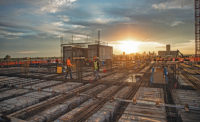Los Angeles World Airports (LAWA), the owner of Los Angeles International Airport, is in the middle of a $4.1-billion capital improvement plan—one of the largest public works programs in California. A key element of the capital plan is a $438-million replacement for the airport's central utilities plant (CUP). The massive new facility has the complexity, scale and scope to present plenty of challenges for the project team.
"There is something for every discipline: major operating systems, four electrical substations, miles of underground pipe and electrical distribution, seismic design and power generators," says Daniel McKelvie, executive vice president of transportation and aviation with AECOM's Los Angeles office. AECOM is program manager on the CUP project and also master plan designer for the entire LAX modernization.
"Ultimately, it involves replacing an aging plant with a state-of-the-art facility without the airport feeling the real impact of construction," McKelvie says.
Construction of the new 75,000-sq-ft CUP started in January 2011. When completed in summer 2014, it will have 8.8 MW of power-generation capacity, up from the current plant's 8.4 MW.
In addition, McKelvie says, "The chillers are among the largest in the world, and can cool 20,000 tons of water .... That's twice the capacity of the old CUP."
Moreover, the project team is constructing the huge CUP in a tight brownfield site. While the work goes on, the nation's busiest airport must continue to operate under business-as-usual conditions.
Jack-and-bore pits for hydronic lines, which will carry water to the far reaches of the airport, were dug next to the roadways that passengers use to reach their terminals. The 50-ton turbines that will generate power for the sprawling complex were delivered in the middle of the night to minimize interference with operations. All the while, the existing CUP kept humming.
"We call it 'downtown LAX,' and it is the tightest spot [at the airport] to build in," McKelvie says. Because of blind corners, workers have to rely on a mirror mounted to a parking structure to watch for oncoming traffic before crossing the street safely to reach the job site.
Stealth Construction
The CUP is the origin and return point for 35 miles of electrical conduit, 25 miles of ducts and 100 miles of cable, all of which had to be dug up and replaced next to other utilities that needed to stay live. "The original idea was to open-cut it, but that involved too much risk," says J. Brent Cashin, project manager for Clark-McCarthy, the new CUP's joint venture design-build contractor. "This was a congested area, so it was easier to dig down and go under the amount of underground utilities left live serving the existing CUP," Cashin says.
The site is so tight that the new CUP's eaves overlap the old plant, which soon will be demolished despite being located just inches from the new structure.
"Usually, [a new CUP] would be a one-story building, but we had to build it to four stories because of the space constrictions and lift the 50-ton turbines onto the second floor," Cashin says. "It all had to be done stealthily. When we brought in the turbines in the middle of the night, the airport [users] didn't even know we had done it …. Construction on the CUP has been 24/7."







Post a comment to this article
Report Abusive Comment